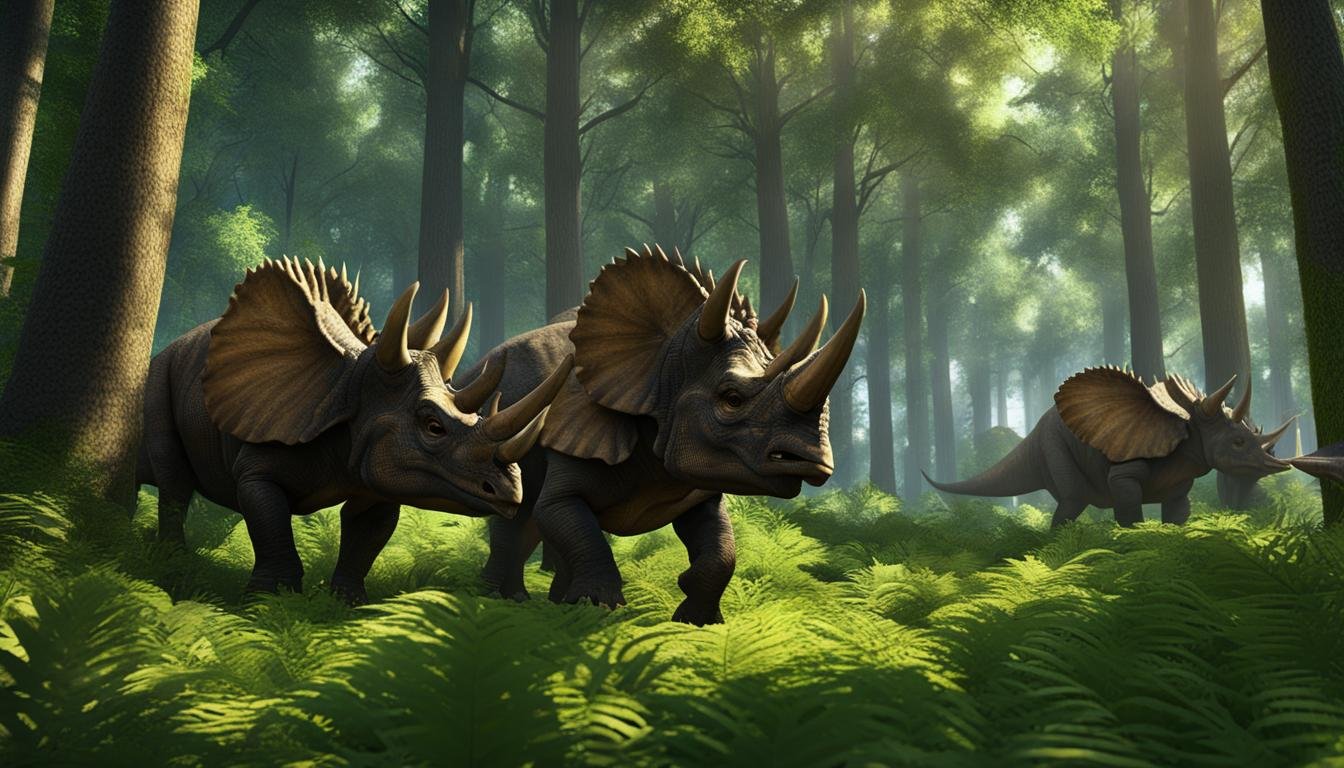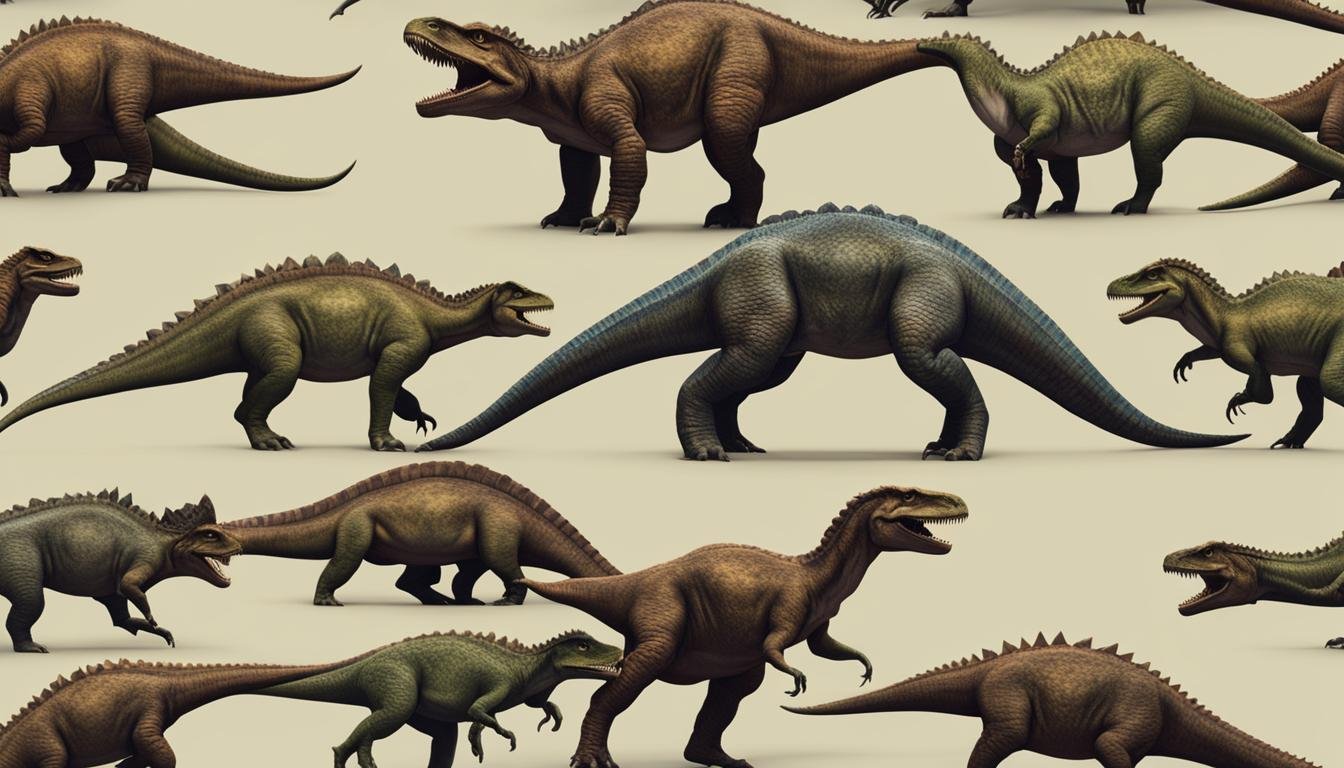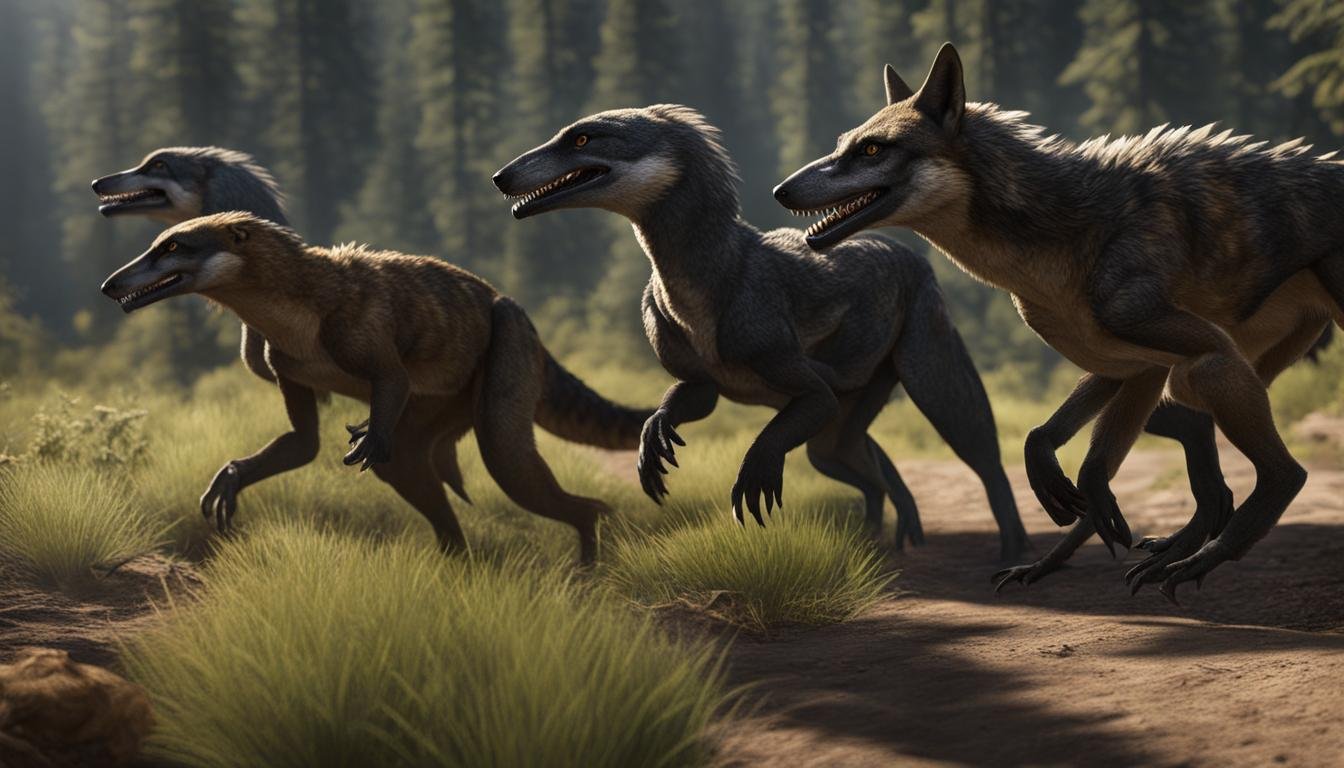Trace fossils, such as fossilized footprints, provide valuable insights into the social dynamics and group behavior of dinosaurs. Through the analysis of these paleontological evidence, scientists can reconstruct the social life of dinosaurs and gain a deeper understanding of their interactions and social structures.
By studying trace fossils, paleontologists can make paleobiological inferences and delve into the behavioral ecology of ancient dinosaurs. These fascinating discoveries shed light on the group behavior and social dynamics of these prehistoric creatures, offering a window into their mysterious world.
| Key Takeaway | Detail |
|---|---|
| Information from Trace Fossils | Trace fossils, such as fossilized footprints, reveal important information about the social dynamics and group behavior of dinosaurs. |
| Reconstructing Social Life | Paleontologists use trace fossils to reconstruct the social life of dinosaurs, understanding their interactions and social structures. |
| Insights into Paleobiology | Trace fossils offer significant insights into the paleobiology and behavioral ecology of ancient dinosaurs. |
| Uncovering Group Behavior | The study of trace fossils is key to uncovering the group behavior and social dynamics of dinosaurs. |
| Contribution to Paleontological Understanding | Trace fossils provide valuable paleontological evidence, enhancing our understanding of dinosaur social life. |
Types of Trace Fossils
Trace fossils offer valuable insights into the social behaviors and interactions of dinosaurs. By examining various types of trace fossils, paleontologists can reconstruct the lifestyles and dynamics of these ancient creatures. Let’s explore some of the most significant types of trace fossils and the information they provide.
Nesting Sites and Fossilized Nests
Nesting sites and fossilized nests provide crucial information about dinosaur reproduction and parenting behaviors. These trace fossils offer evidence of where dinosaurs laid their eggs and raised their young. By studying the arrangement and characteristics of these nests, scientists can deduce the nesting habits and social structures of different dinosaur species.
Migration Patterns and Territorial Markings
Trace fossils related to migration patterns and territorial markings help researchers understand dinosaur movement and behavior. By analyzing trackways, paleontologists can uncover evidence of ancient dinosaur herds and the routes they traveled. Territorial markings, such as scratch marks or scent trails, provide insights into how dinosaurs marked and defended their territories.
Fossilized Droppings and Communal Living
Fossilized droppings, known as coprolites, offer valuable information about the diet and feeding behavior of dinosaurs. By analyzing these trace fossils, researchers can determine the types of plants or prey that dinosaurs consumed. Additionally, trace fossils reveal evidence of communal living, where dinosaurs may have gathered in large groups or herds.
| Trace Fossil Type | Information Provided |
|---|---|
| Nesting Sites and Fossilized Nests | Evidence of reproduction and parenting behaviors |
| Migration Patterns and Territorial Markings | Insights into dinosaur movement and territory defense |
| Fossilized Droppings | Information about diet and feeding behavior |
| Communal Living | Evidence of social behavior and group dynamics |
These various types of trace fossils contribute to our understanding of dinosaur social interaction and group behavior. The analysis of these trace fossils allows paleontologists to reconstruct the paleobiological aspects of dinosaur communities and gain valuable insights into the social structures and dynamics of these fascinating creatures.
Importance of Trace Fossils in Understanding Dinosaur Behavior
Trace fossils, such as fossilized footprints and trails, provide invaluable insights into the behavior and social dynamics of dinosaurs. The study of these trace fossils allows paleontologists to reconstruct crucial aspects of dinosaur behavior, including group behavior, predator-prey relationships, and nesting colonies. By analyzing the fossilized evidence left behind by these ancient creatures, scientists can piece together the social structure and feeding behavior of dinosaurs.
One significant advantage of trace fossils is the ability to observe the spatial distribution of dinosaur communities. Fossilized tracks and trails can reveal gathering sites where dinosaurs may have congregated, giving us a glimpse into their social interactions and behavior. These gathering sites offer evidence of social gatherings and allow us to understand how different species coexisted and interacted within a given ecosystem.
Fossilized trails and nests provide additional clues about dinosaur behavior and habitat utilization. Through the analysis of these traces, paleontologists can infer the movement patterns of dinosaurs and determine their preferred areas for nesting and feeding. This information gives us a deeper understanding of how dinosaurs navigated their environment and adapted to different ecological niches.
The Importance of Feeding Behavior
Trace fossils also offer valuable insights into the feeding behavior of dinosaurs. Coprolites, fossilized droppings, can provide direct evidence of the diet of these ancient creatures. By studying coprolites, paleontologists can determine the types of plants and animals that made up the diet of dinosaurs, further enhancing our understanding of their ecological roles and interactions within their habitats.
| Trace Fossils | Insights |
|---|---|
| Fossilized footprints and trails | Reveal group behavior and social dynamics |
| Nesting sites | Provide evidence of nesting colonies and parental care |
| Gathering sites | Showcase social interactions and species coexistence |
| Coprolites | Offer insights into feeding behavior and diet |
In conclusion, trace fossils play a vital role in understanding dinosaur behavior and social structures. Through the analysis of these fossilized traces, scientists can reconstruct group behavior, predator-prey relationships, and nesting colonies. Trace fossils also provide valuable information about feeding behavior, species interactions, and habitat utilization. The study of trace fossils continues to advance our knowledge of the fascinating world of dinosaurs and their intricate social lives.
Paleobiological Inferences from Trace Fossils
Paleobiologists can glean valuable insights into dinosaur behavior through the analysis of trace fossils. These paleontological evidence provide a window into the past, allowing scientists to make inferences and reconstruct the behavioral dynamics of ancient dinosaurs.
One significant aspect that can be inferred from trace fossils is herd movement and social dynamics. By studying herding evidence, such as trackways and fossilized footprints, paleontologists can understand how dinosaurs moved and interacted in groups. This information contributes to our understanding of their social behavior and provides clues about their social structures.
Trace fossils offer valuable evidence of social interaction among dinosaurs. Fossilized tracks and trails provide insights into how dinosaurs interacted with their environment and with each other. For example, the presence of territorial markings can suggest the establishment of boundaries and dominance within a group. These social gathering evidence can give us a glimpse into the complexities of dinosaur societies.
Territorial markings found in trace fossils can also provide important information about dinosaur behavior. When dinosaurs left behind markings, such as scrape marks or picked surfaces, it indicates the presence of territorial behavior. This evidence allows scientists to reconstruct how dinosaurs defended their territories and how they interacted with other individuals in their environment.
Social Interaction and Territorial Markings in Trace Fossils
The study of trace fossils reveals fascinating details about the social interactions and territorial behavior of dinosaurs. By analyzing these paleontological evidence, paleobiologists can reconstruct behavioral dynamics, herd movement, and social structures of ancient dinosaurs. The richness of trace fossils allows scientists to piece together the puzzle of dinosaur social life and gain a deeper understanding of their fascinating prehistoric world.
The Study and Interpretation of Trace Fossils
When it comes to understanding dinosaur behavior, trace fossils offer valuable insights. Paleontologists employ various techniques and methods to study and interpret these fascinating remnants of prehistoric life.
Trackway analysis is one such technique that helps us reconstruct dinosaur movement and behavior. By examining fossilized footprints and trackways, scientists can gain valuable insights into the locomotion patterns and group dynamics of ancient dinosaurs.
“Trackways provide a glimpse into the daily lives of dinosaurs, revealing how they moved and interacted with their environment.” – Dr. Laura Paleontologist
Another important aspect of trace fossil analysis is coprolites analysis. By studying fossilized droppings, paleontologists can uncover crucial information about dinosaur diet and feeding behavior. These ancient feces can reveal the plant material or bone fragments consumed by dinosaurs, providing insights into their ecological interactions and habitat utilization.
Trace evidence such as bite marks and wear patterns also plays a significant role in the interpretation of trace fossils. These marks left behind on bones or other fossilized remains can offer clues about the behavior and social interactions of dinosaurs, painting a more detailed picture of their lives millions of years ago.
| Technique | Description |
|---|---|
| Trackway Analysis | Examining fossilized footprints and trackways to understand dinosaur movement and group behavior. |
| Coprolites Analysis | Studying fossilized droppings to gain insights into dinosaur diet and feeding behavior. |
| Trace Evidence | Examining bite marks and wear patterns on fossilized remains to infer dinosaur behavior and social interactions. |
Through these techniques, paleobiologists can make paleobiological inferences and reconstruct the behavior and ecology of dinosaurs from trace fossils. The study and interpretation of trace fossils continue to unravel the mysteries of dinosaur social life and contribute to our understanding of their fascinating world.
Challenges in Studying Trace Fossils
Studying trace fossils presents several challenges that paleontologists must overcome to gain a deeper understanding of dinosaur behavior. One of the primary challenges is the preservation of trace fossils. The state of preservation is heavily dependent on the specific environmental conditions in which the fossils were formed. Factors such as sediment deposition, erosion, and exposure to the elements can greatly affect the quality and integrity of the trace fossils.
Another challenge lies in the identification of trace fossils. These fossils come in a wide range of variations, making it difficult to identify and interpret them accurately. Many trace fossils offer limited information, making it challenging to reconstruct the behavior and social dynamics of dinosaurs solely based on these traces.
The destruction and alteration of trace fossils further complicate their study. Natural processes such as erosion can destroy or modify trace fossils over time, leading to the loss or alteration of valuable information. This destruction and alteration hinder paleontologists’ ability to accurately interpret and analyze the fossils.
| Challenges | Description |
|---|---|
| Preservation of Trace Fossils | The quality of trace fossil preservation is influenced by environmental conditions, such as sedimentation and weathering. |
| Difficulty in Identification | Trace fossils can vary greatly, making it challenging to identify and interpret them accurately. |
| Destruction and Alteration of Trace Fossils | Natural processes like erosion can destroy or modify trace fossils, resulting in the loss or alteration of valuable information. |
| Difficulty in Dating Trace Fossils | Trace fossils are often found in sedimentary rocks, which are challenging to date using traditional dating methods. |
In addition, accurately dating trace fossils can be difficult. They are commonly found in sedimentary rocks, which are notoriously challenging to date using traditional radiometric dating methods. This difficulty in dating hampers the establishment of precise timelines and correlations with other geological events.
Despite these challenges, the study of trace fossils remains crucial for reconstructing dinosaur behavior and understanding their social life. Paleontologists continue to develop innovative techniques and methodologies to address these challenges and extract valuable insights from trace fossils.
Conclusion
Reconstruction of dinosaur social life is made possible through the study of trace fossils, offering valuable insights into their behavioral ecology and social dynamics. Paleontologists analyze these paleontological evidence to make paleobiological inferences, shedding light on the fascinating world of dinosaurs.
By examining trace fossils, scientists can reconstruct the social structures, group behavior, and social interactions of ancient dinosaurs. This helps paint a vivid picture of how these creatures lived and interacted with one another. Trace fossils provide a window into the past, allowing us to understand the complexities of dinosaur social life.
The field of behavioral ecology benefits greatly from the study of trace fossils. Through the analysis of these paleontological evidence, scientists can uncover the intricacies of dinosaur social dynamics, enriching our understanding of their evolutionary history and ecological adaptations. Trace fossils stand as tangible records of the interactions and behaviors that shaped the lives of dinosaurs millions of years ago.









